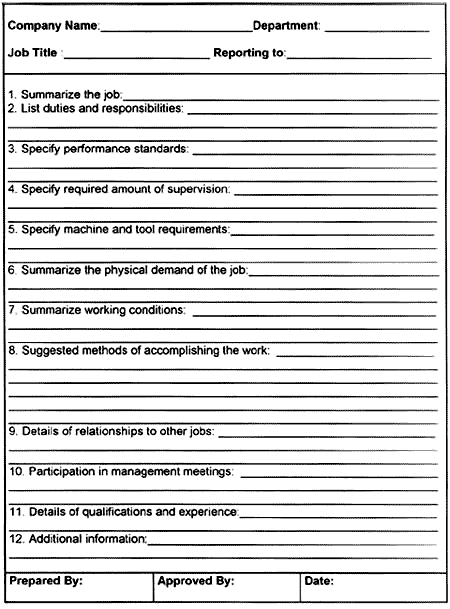HUMAN RESOURCES MANAGEMENT
CHECK POINT 23: JOB ANALYSIS
Please Select Any Topic In Check Point 23 Below And Click. |
|
| |
|
DO I NEED TO KNOW THIS CHECK POINT?
|
|
1. THE PURPOSE OF JOB ANALYSIS |
 |
|
|
THE PURPOSE OF JOB ANALYSIS |
|
Business owners and managers must understand various elements of job analysis which is an important and integral part of the human resources management process.
Sound human resources management practice prescribes creation of various Jobs and Positions designed in accordance with the specific organizational structure of a company. This task represents an important responsibility of the human resources manager and is usually accomplished by means of Job Analysis. The prime purpose of job analysis is to determine duties and skill requirements for a particular job and the type of person who could be suitable for it. |
|
|
|
2. JOB ANALYSIS FOR EMPLOYEE POSITIONS |
 |
|
WHAT IS JOB ANALYSIS? |
|
The Job Analysis process is based on collection and study of information relevant to specific positions within the organization. This process entails several important considerations for employee positions and for managerial positions.
The majority of small business owners and managers never bother to conduct job analysis in their company because they are not familiar with this concept in the first place. However, job analysis represents a very important first step in developing two essential management tools known as Job Descriptions and Job Specifications, which are discussed in detail in Tutorial 2. Both documents are very helpful throughout the employee hiring and management process. For this reason business owners and managers should become familiar with the basic principles of job analysis and implement this task in their organizations.
Job Analysis For Employees Positions is frequently carried out by means of personal interviews, questionnaires or observations and entails gathering of the following information outlined below. |
JOB ANALYSIS INFORMATION FOR EMPLOYEE POSITIONS |
No. |
Details |
1. |
Identification of the job, i.e. title, department. |
2. |
Summary of the job. |
3. |
Detailed list of responsibilities and duties performed. |
4. |
Analysis of accountability. |
5. |
Analysis of performance standards. |
6. |
Analysis of the available amount of supervision. |
7. |
Summary of machine and tool requirements. |
8. |
Summary of working conditions. |
|
|
|
|
3. JOB ANALYSIS FOR MANAGERIAL POSITIONS |
 |
|
JOB ANALYSIS FOR MANAGERIAL POSITIONS |
Job analysis is particularly important in evaluating specific requirements for various managerial positions. This usually depends upon company size and the nature of its activities.
Job Analysis For Managerial Positions entails additional considerations in the following areas outlined below. (4) |
JOB ANALYSIS INFORMATION RELATED TO MANAGEMENT POSITIONS |
No. |
Details |
1. |
Working with subordinates. |
2. |
Organizing work with subordinates. |
3. |
Work planning and scheduling. |
4. |
Maintaining efficient quality and production. |
5. |
Maintaining safe and clean work areas. |
6. |
Maintaining equipment and machinery. |
7. |
Compiling records and reports. |
|
|
|
|
4. ADVANTAGES OF JOB ANALYSIS |
 |
|
Job Analysis is advantageous for several reasons outlined below. |
ADVANTAGES OF JOB ANALYSIS |
No. |
Details |
1. |
Job analysis provides guidance throughout recruitment and selection of employees. |
2. |
Job analysis helps management to understand various requirements of a particular position. |
3. |
Job analysis helps management to develop an appropriate compensation package, e.g. salary, commissions, bonus, fringe benefits. |
4. |
Job analysis is useful in developing suitable training and development programs for employees. |
|
|
|
|
5. TWO PRIME PRODUCTS OF JOB ANALYSIS |
 |
|
Two prime products of job analysis are Job Descriptions and Job Specifications illustrated below. Both documents are discussed in detail in Tutorial 2. |
TWO PRIME PRODUCTS OF JOB ANALYSIS
 |
|
 |
Job
Descriptions |
|
Job
Specifications |
| Job descriptions summarize a list of duties and responsibilities for various positions and provide specific guidelines for employees regarding what they are supposed to do within the company to meet its organizational objectives. |
|
Job specifications are very useful during the employee hiring process and provide specific guidelines for business owners and managers regarding the skills, education, work experience, managerial experience, and other human assets, which may be required by applicants to perform a particular job within the organization. |
| |
|
|
|
|
|
6. JOB ANALYSIS AND RELATED MANAGERIAL TASKS |
 |
|
IMPLEMENTATION OF THE JOB ANALYSIS PROCESS |
Business owners and managers must summarize the details of various Job Requirements Factors and Human Requirements Factors related to specific positions within the organization to initiate a meaningful Job Analysis Process within the organization.
The interaction between the prime products of job analysis and other elements of human resources management is illustrated below.
|
JOB ANALYSIS AND RELATED MANAGERIAL TASKS
 |
|
 |
|
Job Requirements Factors
•
•
•
•
•
|
- Identify and examine the job.
- List duties and responsibilities.
- Establish accountability procedures.
- Examine performance requirements.
- Examine work requirements and working conditions.
|
|
|
Human Requirements Factors
•
•
•
•
•
|
- Identify skills, education, and experience requirements.
- Identify planning, organizing, and supervising ability requirements.
- Identify personality requirements.
- Identify compensation requirements.
|
|
 |
|
 |
Job Analysis |
•
•
•
•
|
- Determine duties, responsibilities, and accountability.
- Determine skills, education, and experience requirements.
- Determine managerial and personality requirements.
- Evaluate compensation requirements.
|
|
 |
|
 |
Job Descriptions
Prepare a list of the job's duties, responsibilities, and accountability. |
|
Job Specifications
Prepare a list of the job's human requirements, i.e. skills, education, experience, managerial abilities, and personality. |
 |
|
 |
Job Evaluation, Classification, And Grading |
|
Determine the relative worth of the job using one of the following methods:
- • Survey of salaries and wages in the specific industry.
- • The ranking method.
- • The job classification method.
- • The point method.
- • The factor comparison method.
|
 |
Job Compensation Plan |
Develop an appropriate job compensation plan that should include the following:
- • Basic job compensation.
- • Financial incentives.
- • Employee benefits.
|
|
|
|
|
|
7. SIX STEPS IN THE JOB ANALYSIS PROCESS |
 |
|
|
A typical Job Analysis Process entails six steps outlined below. (5)
|
THE JOB ANALYSIS PROCESS

Step 1: Identify The Application Of The Job Analysis Information.
This information can be used to prepare a job description or a job specification, to develop an employee compensation program, to determine employee training needs, or to provide the basis for employee performance appraisal.

Step 2: Collect And Evaluate The Job Analysis Information.
This information may include existing organizational chart, job descriptions, job specifications, or compensation reports.

Step 3: Select Representative Positions For Job Analysis.
Job analysis in a small or medium-sized company may include positions of the president, vice presidents, marketing or sales manager, financial manager, production or operations manager, production operator, and administration clerk.

Step 4: Collect And Evaluate The Job Analysis Information.
Collect and evaluate the information related to the selected representative positions, as described earlier.

Step 5: Review The Information With Job Analysis Participants.
The job analysis information should be reviewed with the selected employees who participate in the job analysis process. Each participant should have the opportunity of studying and understanding the specific details related to his or her position in light of the job analysis results.

Step 6: Develop Job Descriptions And Job Specifications.
Job descriptions and job specifications represent the two prime products of the job analysis process. A job description specifies the duties, responsibilities, and accountability of a particular position. A job specification outlines the specific requirements for a particular position. |
|
|
8. JOB ANALYSIS INTERVIEW QUESTIONS |
 |
|
|
Some of the typical Job Analysis Questions frequently asked during a job analysis interview are outlined below.
TYPICAL JOB ANALYSIS QUESTIONS
No. |
Details |
1. |
What is the essence of work in your position? |
2. |
What are the main duties and responsibilities of your position? |
3. |
In what different physical locations do you have to work? |
4. |
What level of education is required for your position? |
5. |
What level of experience and skills are required for your position? |
6. |
What type of certification and licensing is required for your position? |
7. |
What is the level of authority vested in your position? |
8. |
What is the level of accountability and to whom are you accountable? |
9. |
What type of activities does this position entail? |
10. |
What are the safety conditions related to this position? |
11. |
Does your work present any type of hazardous or unusual working conditions? |
12. |
What are the emotional, physical, and mental demands of your position? |
|
|
9. JOB ANALYSIS IN A SMALL BUSINESS |
 |
|
JOB ANALYSIS IN A SMALL BUSINESS
Business owners and managers in many small and medium-sized companies often use a simple Job Analysis Questionnaire to gather relevant information. The business owner or manager must simply prepare a list of appropriate positions that are in need of job analysis, and identify whether these positions are new or existing ones.
For all existing positions, the business owner or manager must issue a job analysis questionnaire to appropriate employees to assist in gathering relevant information. This questionnaire, in essence, lists a number of specific questions which should be answered by a particular employee who participates in the job analysis process, and should be reviewed and approved by the job incumbent's supervisor. |
|
|
10. SMALL BUSINESS EXAMPLE
JOB ANALYSIS QUESTIONNAIRE |
 |
|
 |
|
11. WHAT SHOULD BE DONE AFTER JOB ANALYSIS? |
 |
|
DEVELOP JOB DESCRIPTIONS AND JOB SPECIFICATIONS
Once all relevant questions are answered, business owners and managers must summarize the appropriate results and proceed with the preparation of job descriptions and job specifications for various positions with the organization.
Job Descriptions and Job Specifications are used extensively in evaluating, classifying, and grading various jobs and in preparing compensation plans.
Note:
Job Descriptions And Job Specifications are discussed in detail in Tutorial 2. |
|
|
12. FOR SERIOUS BUSINESS OWNERS ONLY |
 |
|
ARE YOU SERIOUS ABOUT YOUR BUSINESS TODAY? |

Reprinted with permission. |
|
13. THE LATEST INFORMATION ONLINE |
 |
|
|
| |
LESSON FOR TODAY:
Good Job Analysis Is A Serious Job! |
|
| |
|





